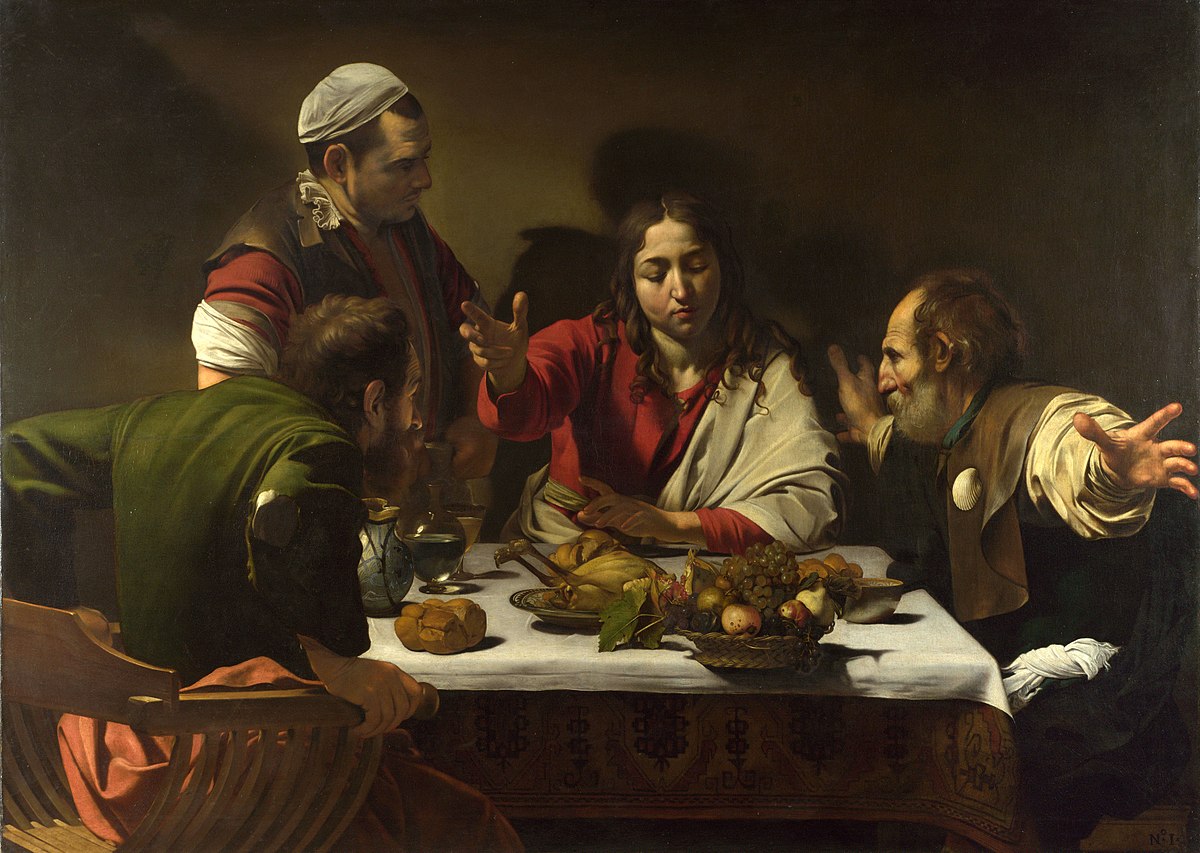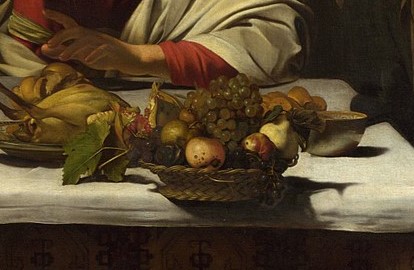Caravaggio's Fruit Bowl

Caravaggio’s The Supper at Emmaus (1601) is a religious history painting, painted at the height of Caravaggio’s fame. There is a lot going on in this painting (it’s one of my favourites, I could seriously talk about it for hours, if anyone wants…), so I am going to concentrate on the still life within it, or try to, at least: the bowl of fruit.
Caravaggio’s composition and verisimilitude are (in my opinion) unmatched. In this painting, depicting the moment that Christ is revealed to the two apostles at the inn in Emmaus, is like a photograph with the intensity of action that is being displayed. Even the way the scene is cropped at ¾ length feels like a zoomed in cinema shot, and we’re just waiting to move onto the next frame.
The way the apostle in the chair is jumping out of his seat, which is disappearing out of the frame, pushing the scene out further than we can see. The way the second apostle is throwing his arms out in a crucifixion position, reaching out of the frame to us the audience. It’s dynamic and active and so deeply contrasted with the peaceful pose of Christ, blessing the bread. It's also contrasted with the rather befuddled innkeeper staring at the scene with no idea what is going on but casting a halo shadow behind Christ’s head.
Caravaggio loved a good contrast, whether it was with light, being a master of chiaroscuro (my favourite word), or action, to highlight the focus point of his scene. In this case, the focus of the painting of unquestionably Christ.
With all this movement (and contrasting stillness) it is easy to overlook the bowl of fruit, perched rather precariously on the edge of the table. Caravaggio was a master of still lives, having made his bread and butter (literally) in his early career churning out still lives for sale. Maybe he just added the fruit to show off. He was a master of realism after all, and even at the time critics (wealthy patrons) commented on how astonishing it was to see a painting of fruit that looked like you could pluck it straight out of the bowl and eat. Even the spots on the apple add to the realism. This fruit exists in our space.
However, nothing about this painting was unplanned. There is only evidence of one change to the composition of this painting (the placement of a knee), which was incredibly rare for the time and meant that Caravaggio knew exactly what he wanted to paint and why. The fruit bowl is of compositional significance.

First of all, the placement of the bowl. As I said earlier, it is a rather precarious placement, hanging over the edge of the table, with a shadow of the protruding base clearly visible. As with other framing devices in this painting, this is designed to draw the viewer in. The bowl is entering the audience’s space and serves as a bridge between us and the scene.
It is slightly funny that the inclusion of the still life aspect of this painting was a point of praise at the time of its painting, because it was also one of the few points of criticism: there is no way all these fruits could have been in season at the same time! Apples and grapes at once? Never! Bellori, a relatively contemporaneous biographer of Caravaggio, highly criticised this supposed goof, as it took away from the immersive realism that the verisimilitude of structure evoked (sorry for all those words – I did Art History at university and haven’t been able to show off in a while).
But, the whole point of this moment caught in Caravaggio’s imagination is that it is timeless. The biblical scene exists in its moment, true, but it also exists throughout time and is relevant throughout the year. Again, it doesn’t matter what time of year it is, the fruit provides a bridge between the past and now. There is a tangible connection between the scene and us, the viewers.
There is a more literal meaning behind the fruit being caught between the image of Christ after the resurrection and us the audience (Caravaggio painted this with a Christian (Catholic) audience in mind) and that is the connection with first fruits. First fruit is a religious offering of harvest produce to a deity. References to First fruits appear throughout the Old Testament – people were instructed to give the first fruits of the harvest to God, to honour that God had made the harvest possible, but also people (people of Israel) were the first fruit devoted to God. This was taken up by early Christian writers who referred to Christ as ‘the first fruit of the dead’.
So, the meaning here is manifold: the fruit, sitting between the audience and Christ serves as an offering to God (Christ); is thanks to God’s abundance and benevolence; is a symbol of Christ himself and his sacrifice on the cross; and is a representation of Christians offering themselves to God (again, it was painted for 17th century Catholics), which is highlighted by the ignorant innkeeper, who should be shrouded in darkness, but is still illuminated by the light being reflected off Christ.
And speaking of light in this painting, there is a lot going on. There is no tangible or singular light source, which is slightly unusual in a Caravaggio painting, and instead light and shadow is used to highlight what Caravaggio wanted it to highlight. This could be seen as a metaphor for ‘the light of recognition’, which is the direct theme of this scene (the apostles recognising Christ after the journey on the road to Emmaus). One of the little easter eggs, for want of a better term and pardon the reference, is that the shadow from the apples and pear leaves hanging above them form a fish (a symbol of Christ) on the tablecloth!









